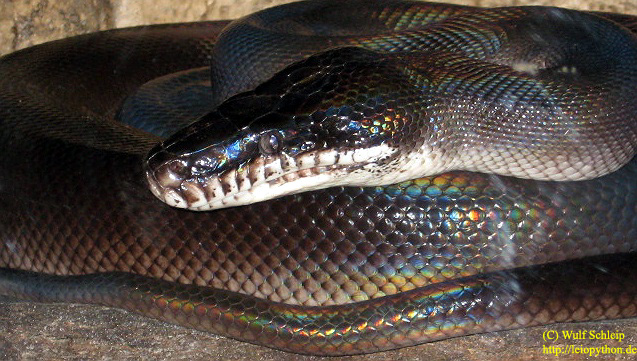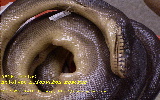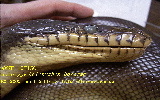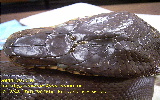Content L. albertisii <--> L. montanus
L. albertisii <--> L. montanus 
Species
Leiopython meridionalis Schleip, 2014

Common name
Southern White-Lipped Python, Black White-Lipped Python
Holotype
AMNH R-107150, a large male specimen from Wipim, Western Province, PNG, 2.41 m in length, collected by F. Parker in August 1969.
Description of the holotype
Supralabials 13/13, first two pitted, fifth to sixth entering the orbit and with a lateral depression; infralabials 18/18; loreals 1/1; preoculars 1/1; postoculars 3/3, without the whitish postocular spots; supraoculars 1/1; one pair of prefrontals; anterior parietals in median contact anteriorly, but do not meet uppermost postoculars, right parietal scale larger than the left; two scales behind the parietals, the left smaller than the right, both separated at the median line by an elongate scale; enlarged anterior temporals; midbody 50; ventrals 264; anal entire; subcaudals 73.



Diagnosis
Leiopython meridionalis can be distinguished from Leiopython fredparkeri, Leiopython albertisii, and Leiopython biakensis by the presence of only one pair of parietals followed by a characteristic scale pattern of two small scales separated from the median line by an elongate scale that gets wider posteriorly (see Fig. 2B, 6C). It further differs from the former species in a lower average number of dorsal midbody rows, and from the latter two species by the absence of the whitish postocular spot. Furthermore, Leiopython meridionalis exceeds Leiopython albertisii and Leiopython biakensis in adult and hatchling body size and is darker in color (Parker, 1982; Barker and Barker, 1994; O’Shea, 1996). Molecular evidence also supports the separation of Leiopython meridionalis from Leiopython albertisii (Fig. 8). It differs from Leiopython montanus in the number of loreals and prefrontals as well as in lower midbody scale row counts and in the average number of postoculars. Leiopython meridionalis can be distinguished from Leiopython huonensis by the absence of the whitish postocular spot, the characteristic scale arrangement in the parietal region (Leiopython huonensis has one pair of parietals followed by small, irregular scales) and in higher ventral scale counts. Leiopython meridionalis also occurs in drier and hotter climate conditions than other taxa of the genus (detailed below).

Figure 9: Cladogram of the maximum likelihood (ML) tree. Numbers above the branches represent bootstrap proportions. Bootstrap proportions less 50% are not shown.
Description
Leiopython meridionalis can reach a length up to 2.8 m (~9 ft.) and an average weight of 8 kg. The body color is blackish-blue dorsally fading to grayish ventrolaterally and white laterally. The dorsal surface of the head is shiny black and the chin is white. The whitish spot behind the eye is absent. 12-14 supralabials, 15-18 infralabials, single loreal and preocular; 3-4 postoculars, 4-5 anterior and posterior temporals, one large pair of prefrontals, single pair of parietal scales followed by a characteristic set of scales; 45-52 dorsal midbody-rows; 264-278 ventrals, anal entire; 64-73 subcaudals.
Etymology
The specific name meridionalis derives from the Latin word for 'southern' and refers to the southern distribution of this White-lipped python.
Variation
Variation in morphological characters was found in several specimens and included the presence of suboculars, the number of supralabials entering the eye, as well as the number of postoculars. Furthermore, specimens from the Western Province showed significantly higher average subcaudal scale counts and higher average number of infralabials than found in populations from the Central and Milne Bay Provinces. In two specimens, one from Kokoda and the other one from Garaina (both in the Highlands of the Owen Stanley Range) two pairs of parietals were present (for the latter see also McDowell, 1975). In the Kokoda specimen, the anterior parietal scales were also separated along the median line by three small interparietals. Furthermore, the Kokoda specimen showed an unusual head color, perhaps caused by preservation. Moreover, this specimen also had several black markings on the genial scales of the throat, only seen in one other specimen examined from Popondetta. Future research is needed on these populations! A single specimen from Timika, southwest Papua, as well as a number of live specimens exported for pet trade from Indonesia (examined by the author) as the so-called black race White-Lipped Python showed two pairs of parietals, not seen in specimens of L. meridionalis from PNG and Merauke. The whitish spot found in L. albertisii was absent in all specimens of L. meridionalis examined.
 Figure 10: Parietal scales structures of some Leiopython meridionalis from different localities
Figure 10: Parietal scales structures of some Leiopython meridionalis from different localities
Content L. albertisii <--> L. montanus
L. albertisii <--> L. montanus 
